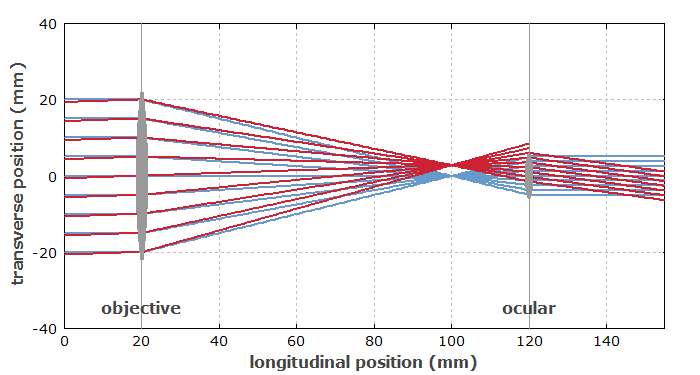Vignetting
Definition: a reduction of image brightness in peripheral regions
German: Vignettierung
Category: vision, displays and imaging
How to cite the article; suggest additional literature
Author: Dr. Rüdiger Paschotta
The field of view of an objective is limited by some kind of optical aperture acting as the field stop. Frequently, the field of view is sharply defined – for example, by the dimensions of the image sensor of a photo camera or by a diaphragm placed in an image plane. However, there are also cases where the field-limiting aperture is substantially away from an image plane, which results in a gradual reduction of image brightness in the outer regions. On the other hand, an aperture stop does not cause vignetting, but a reduction of image brightness in all regions, including the center.

As an example, we consider a Keplerian telescope, which consists of two lenses: an objective and an ocular (eyepiece). It provides some angular magnification for viewing distant objects according to the ratio of focal lengths of objective and ocular. The field of view is limited by the size of the ocular lens, and that element happens not to be placed in an image plane. As is shown in Figure 1, for certain image directions a part of the light rays coming from an object point can still get into the ocular, while other rays are lost. Therefore, the corresponding image point on the retina in the eye will have a reduced brightness. That problem can be solved by inserting an additional field lens.
Vignetting can also have other causes, not related to apertures. For example, if a photographic objective is designed such that the peripheral regions of the film or the image sensor are illuminated with a substantial angle of incidence, they may obtain a reduction of brightness. This is particularly the case for image sensors with microlens arrays. In such cases, the objective is often designed for image-telecentric operation in order to avoid vignetting.
In photography, some substantial vignetting may even be welcome as a special decorative effect for certain situations (e.g. for portraits). However, one would usually not like a photo camera to exhibit significant vignetting as a general feature; one would rather apply some vignetting with image editing software where required. Similarly, a good astronomical or terrestrial telescope should not exhibit vignetting.
In principle, vignetting in a digital photo camera can also be compensated digitally, i.e., by the operation software. With that approach, however, one would lose some amount of dynamic range for the outer regions of images.
Questions and Comments from Users
Here you can submit questions and comments. As far as they get accepted by the author, they will appear above this paragraph together with the author’s answer. The author will decide on acceptance based on certain criteria. Essentially, the issue must be of sufficiently broad interest.
Please do not enter personal data here; we would otherwise delete it soon. (See also our privacy declaration.) If you wish to receive personal feedback or consultancy from the author, please contact him e.g. via e-mail.
By submitting the information, you give your consent to the potential publication of your inputs on our website according to our rules. (If you later retract your consent, we will delete those inputs.) As your inputs are first reviewed by the author, they may be published with some delay.
See also: imaging, objectives, field of view
and other articles in the category vision, displays and imaging
 |



If you like this page, please share the link with your friends and colleagues, e.g. via social media:
These sharing buttons are implemented in a privacy-friendly way!